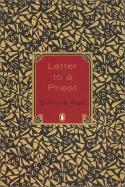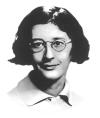Issue Date: February 13, 2004
Brilliant and singular, Simone Weil spent her brief life obsessed with the search for faith. Reviewed by GRANT GALLICHO Simone Weil was direct and difficult. Simone de Beauvoir found out the hard way. In 1928, the two budding French philosophers were preparing entrance exams for the École Normale when they met at the Sorbonne. De Beauvoir writes of Weil in her Memoirs of a Dutiful Daughter, “She intrigued me because of her great reputation for intelligence and her bizarre outfit.” She was also fascinated that Weil had wept at news of the Chinese famine. “I envied her for having a heart that could beat right across the world.” She approached Weil, who declared that the only thing that mattered was the coming revolution that would feed the starving people of the world. De Beauvoir replied just as firmly, “The problem was not to make men happy, but to find the reason for their existence.” “It’s easy to see that you’ve never gone hungry,” Weil snapped. So much for that broad-beating heart.
This story captures Weil’s compassion and rigor in a way that Letter to a Priest -- by its nature -- cannot, but it doesn’t capture her intellect, which is very much on display in the Letter in all its breadth, vigor and eccentricity. Although Letter to a Priest was not published until 1951 (the American edition appeared three years later, in 1954), Weil composed the letter in 1942, at the age of 33, near the end of a four-month stay in New York. She spent most of her time there attempting to secure passage to London so she could parachute into France as a “frontline nurse.” She was neither a nurse nor a skydiver. Weil’s characteristic introspection was in high gear, and so she busied her mind with what had become an obsessive preoccupation: scrutinizing the obstacles to her entrance into the Catholic church. This may seem an odd preoccupation for a secular Jew, but for Weil, the truth of Christianity, more specifically the Resurrection and the sacraments, was the summit of her philosophy. The extraordinary work and life of Weil -- the two cannot be separated -- are not easily summarized. She has been described as a leftist intellectual for her affection for the worker and hatred of oppression, but her “denial of progress and her cult for tradition,” as her friend and fellow philosopher Gustave Thibon put it, complicate that description. The mystic threads in Weil’s thought and experience -- she claimed to have had three mystical experiences of Christ -- make it even more difficult to categorize her. She came to a profoundly difficult relationship with Christianity and, while continuing her political and philosophical pursuits, much of her later life was taken up with examining Christianity and her relationship to it, especially Catholicism. In search of answers to her religious dilemma, Weil visited Fordham philosophy professor Dietrich von Hildebrand. She pressed him on whether her ideas about Christianity would prevent her from joining the church, informing him of her belief that authentic Christianity was more akin to classical Greek thought than to the Old Testament. The professor assumed she had been infected by Nazi anti-Semitism. She moved on to a priest, John Oesterreicher, with whom she had a heated exchange explaining her belief that the central Christian mysteries were better expressed by the Greek philosophers than by the New Testament. Vexed, Oesterreicher tried to pass her on to another priest, but Simone was hip to this game of hot potato: “I wonder whether this new fellow will pass me on to yet another,” she wrote her parents, “and so on, until none of them are left.” Her compatriot and fellow philosopher Jacques Maritain recommended her to the French Dominican Édouard Couturier, who was, by all accounts, brilliant. More important to Weil, he was sympathetic to her theological questions. He became her spiritual adviser. So impressed was she that she urged her brother André to have his son take religious instruction from Couturier. When André agreed, she wrote asking Couturier to take on the task. This letter would serve as a kind of rough draft of Letter to a Priest. She wrote, “I would like for you to tell me, after study and reflection and in a precise and completely certain manner, if a priest legitimately can or cannot grant baptism to a person who has the following opinions and could not be persuaded to abandon them.” The draft set forth 15 of her “supposed heresies.” These are contained and developed in the Letter. She sent Couturier a final draft -- comprising 32 manuscript pages -- one day before she departed for London, less than a year before her death in 1943. His reply, if he sent one, is not extant. Letter to a Priest begins with Weil’s usual forthright tone: “When I read the catechism of the Council of Trent, it seems as if I had nothing in common with the religion there set forth.” But, she goes on, “When I read the New Testament, the mystics, the liturgy, when I watch the celebration of the Mass, I feel with a sort of conviction that this faith is mine or, to be more precise, would be mine without the distance placed between it and me by my imperfection.” Weil finds herself in a “painful spiritual state,” one that would be “acceptable where there is clarity.” The point of her letter was “to enumerate for you a certain number of thoughts which … form a barrier between me and the church.” What she wanted from Couturier was “a definite answer … regarding the compatibility or incompatibility of each of these opinions with membership of the church.” She describes her opinions as mostly provisional, having “for me various degrees of probability or certainty, but all go accompanied in my mind by a question mark.” She numbers these “thoughts” one to 35, each varying in length from one paragraph to several pages. Weil is working in the mode of Pascal’s Pensées -- a book she admired -- and is not presenting a systematic argument. But even Weil aficionados are likely to be puzzled by some of her assertions. She is desperate to connect Christianity with its Greek antecedents -- connections she terms “affinities.” Take, for example, her discussion of how many names of Greek divinities are “in reality various names for designating one single divine person, namely the Word.” Athena, she argues, is a name for the Holy Spirit. “Athena came forth from the head of Zeus after the latter had devoured his wife, Wisdom, who was pregnant; she ‘proceeds,’ therefore, from God and his wisdom. Her emblem is the olive, and oil, in the Christian sacraments, is symbolically connected with the Holy Spirit.” At this point, we have olives, and olives have oil, and Christians use oil sacramentally to denote the presence of the Holy Spirit. And Weil continues: “Christ began his public life by changing the water into wine. He ended it by transforming the wine into his blood. He thus marked his affinity to Dionysius.” And still more: “[Christ’s] words: ‘Except a corn of wheat die’ express his affinity to the dead and resuscitated divinities which were represented by vegetation, such as Attis and Proserpina.” This associative thinking goes on. It is imaginative, to be sure, but is this line of reasoning more a function of her abiding admiration for all things Greek (she abhorred all things Roman) than the result of dispassionate study of Christianity? Where was the mental mechanism that would lead anyone else to ponder the plausibility of Christ’s post-figuring of Proserpina and Attis on the basis of six words? But the desire to prosecute Weil should be tempered. After all, this is just a letter -- one that contains instances of punchy, relevant brilliance. Her meditations on the relationship between Catholicism and other religions are striking: “When Christ said: ‘Go ye therefore, and teach all nations, and bring them glad tidings,’ he commanded his apostles to bring glad tidings, not a theology.” There are disturbing elements in her thinking, as well. For example, her explanation of why the apostles misconstrued Christ’s command: It “was misunderstood, because of the ineradicable nationalism of the Jews.” She believed this to be characteristic of all Jews. Letter to a Priest displays some of Weil’s most exasperating traits: her tragic misreading of the Hebrew scriptures and concomitant denigration of the Jewish people. Some of her harshest critics, such as Rachel Brenner, have called her a self-hating Jew, and even her close friend Thibon, who was responsible for publishing the first collection of her notebooks, Gravity and Grace, spoke of her “anti-Semitism.” Fair enough. But “self-hating Jew” seems too easy and perhaps anachronistic to be applied to Weil. She was raised by agnostic parents. Her familiarity with Jewish and Christian scripture was minimal, as was her familiarity with Jewish religious tradition. Her Jewish identity was too anemic to rise to the level of self-hate. More likely, Weil’s stubborn whimsy landed on an erroneous interpretation of Hebrew scripture. That is, her vehement dislike of anything smacking of nationalism or, more broadly, groupthink (she was frightened of decisions made by clusters of people, yet another reason for her allergy to Christian baptism) steered her to believe that the Jewish people’s claim to be God’s chosen people was “nationalistic,” born of a will to dominate, a criticism she leveled at Jews en masse. This interpretation informed her lament: “It was … a misfortune that the Jewish tradition in Christianity gave it a heritage of texts that often express a cruelty, a will to domination, an inhuman contempt for the conquered.” The conquered? Is she still talking about Jews, or has she slipped into a critique of Romans? Penguin Books chose to reprint Letter to a Priest in 2003. There’s no note in the book to indicate why, but it may be an effort to capitalize on the curiosity Weil’s brilliant mind and tortured life have often evoked in readers and the recent scholarly attention given Weil with the publication of Francine du Plessix Gray’s biography of her. As du Plessix Gray ironically points out, many of Weil’s traits fit a Jewish stereotype: “her love of polemic; her penchant for Talmudically hairsplitting judgments; her tendency to rhetorical extremes; stern emphasis on an absolute obedience to God’s will.” What’s more, Weil was not wholly condemnatory of Jewish scripture. Du Plessix Gray also notes that Weil was fond of Job, many of the Hebrew prophets, the Song of Solomon, and several psalms. As Weil’s pensées accumulate, the reader may begin to feel sympathy for those priests who endured her relentless questioning. I have long admired Weil’s writing, her philosophical acumen, her devotion to justice, however rigid, and her commitment to belief in Jesus, however misinformed it could be. For a proper introduction to Weil, it may be better to start with something a bit fleshier, The Need for Roots or Waiting for God. Even better, find out about her life. Learn how she arrived at the need to write Letter to a Priest by picking up du Plessix Gray, or, if you have the time and if you can carry it, Simone Pétrement’s hefty and sometimes ponderous biography, Simone Weil: A Life. Weil’s thought cannot be separated from her life and her struggles. Letter to a Priest is a late-stage account of her search for faith. Come back to it when you’ve perused those of Weil’s works that give context to her desperate and sometimes elusive inquiries about being baptized. Grant Gallicho is the associate editor of Commonweal magazine. National Catholic Reporter, February 13, 2004 |

